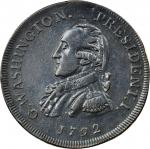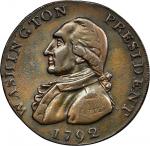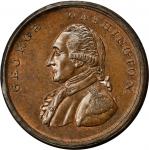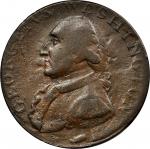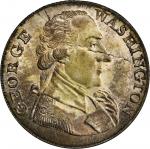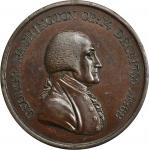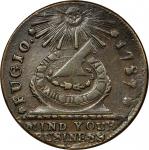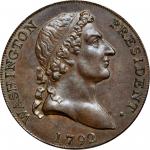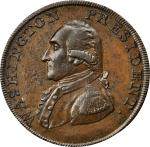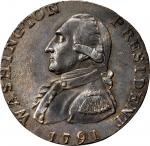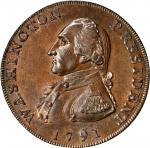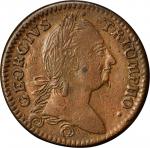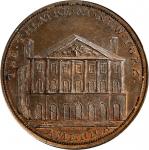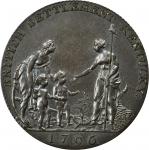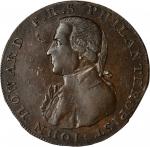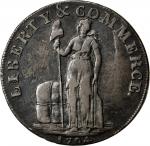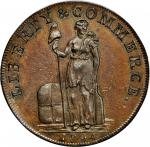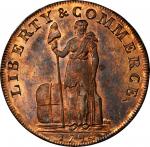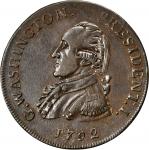1792 Washington Getz Pattern. Small Eagle. Baker-25, Musante GW-22, W-10775. Copper. Plain edge. AU-58 (PCGS).263.1 grains. An extremely important specimen of this important 1792 pattern, coined by Peter Getz of Lancaster, Pennsylvania between January 12 and March 27, 1792, to meet the statutory requirements of the never-passed Senate version of the Mint Act of 1792. The surfaces are glossy and beautiful, dark chocolate brown with attractive undertones of lilac and gold. Both sides retain some of the prooflike character associated with high grade examples from the earliest state of these dies, and the reverse lacks any hint of the spalling line that appears in later die states to the right of the tip of the eagles tail. The centering is ideal, and the obverse shows a steady arc of peripheral denticles from 3:00 to 9:00. The Washington portrait is struck into superb relief, and the usually weak verticals on the eagles shield are all present here. Only the most minor evidence of handling is seen aside from a short scratch between the olive branch talon and the tail, and a tiny rim nick below the arrow feathers. The visual appeal exceeds the grade on this marvelously preserved and simply beautiful specimen.<p>In April 1792, the Congress sent off a Mint Act for President Washingtons signature. It was essentially the House version of the bill, insisting that American coins depict "an impression emblematic of Liberty." The Senate version of the bill, which never saw the Presidents desk, was much different, and Washingtons opposition to the concepts therein may have helped kill it. By the terms of the Senate version, United States coins would have depicted: <p>"An impression or representation of the head of the President of the United States for the time being, with an inscription which shall express the initial or first letter of his Christian or first name, and his surname at length, the succession of the presidency numerically, and the year of the coinage; and upon the reverse of each of the gold and silver coins, there shall be the figure or representation of an eagle, with this inscription - United States of America."<p>If that design prescription sounds familiar, it is because it is precisely what appears on the Getz patterns, down to the I representing "the succession of the presidency numerically" that follows G. WASHINGTON PRESIDENT. <p>Though this specimen was undoubtedly struck early within the life of these dies, it appears Getz dream of work with the United States Mint did not cease when the coinage acts language made his patterns obsolete. These dies may have been put back into use early in 1793, producing small planchet pieces whose weight intended to meet the standard for the new cent coinage. One specimen, in the Lasser Collection at Colonial Williamsburg, is overstruck on a 1794 cent. This portrait punch also created new dies: the 1796-dated die used on the unique silver "Drumheller Dollar," which also used this exact reverse die; as well as the 1797 Getz Washington Masonic medal. These dies look to have made their way into the hands of Philadelphia mechanic John Harper, whose August 1797 estate listing cites "2 Dies of General Washington Heads, 1 [ditto] of the face Masons coat of arms." The nature of Getzs relationship to Harper has yet to be uncovered.<p>According to George Fulds <em>The Washington Pattern Coinage of Peter Getz</em>, where this piece is listed as specimen 18, "the pedigree given in the 1973 sale and repeated in 1976 as ex Brand and Hall is entirely fictitious." This may be true, but the language understates the difficulty in attributing the provenance of rarities that emerged onto the marketplace in the 1950s and 1960s. The Brand Estate continued to shed enormous quantities of material of all kinds, mostly privately or into auctions where incomplete provenance was de rigueur. Even with a careful look into the Brand ledgers, meticulously attributing and identifying each piece he owned, it is sometimes difficult to identify exactly what pieces came from the Brand Estate. Add to this the fact that Brand coins often came from the same dealer sources as coins from the enormous Col. Green estate in this era, and the opportunity for confusion was rich. None of this is to deny another obvious point: dealers sometimes concoct provenance out of whole cloth.<p>Fuld counted 55 total specimens of the 1792 Getz pattern in copper, of which 44 were of this plain edge type. Most are well worn, many are damaged (and some repaired), and holes are not uncommon. PCGS has certified just four at Mint State levels, the best of which is the Norweb coin sold in our auction of November 2006. This piece ranks high on any census of these special coins ranked by overall quality. It has been off the market for more than 42 years.PCGS Population: 1; 5 finer (MS-64 BN finest).From the Archangel Collection. Earlier, from Stack’s sale of the Laird Park Collection, May 1976, lot 182; William Anton, Jr. to Alan Weinberg to Jon Hanson; Stack’s sale of June 1973, lot 868.

